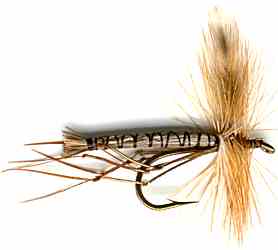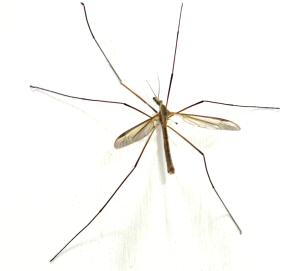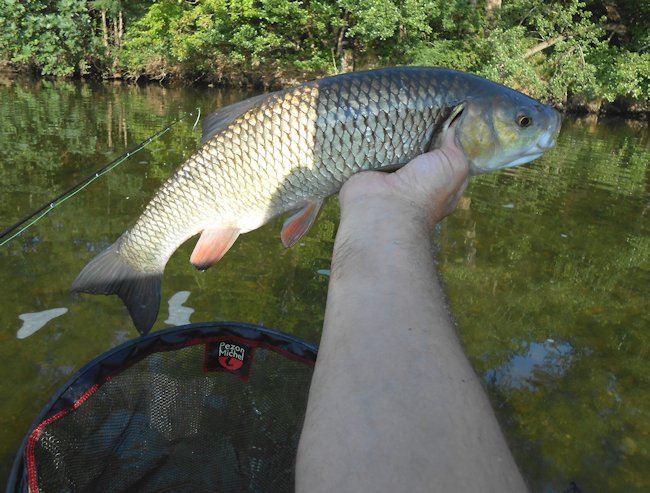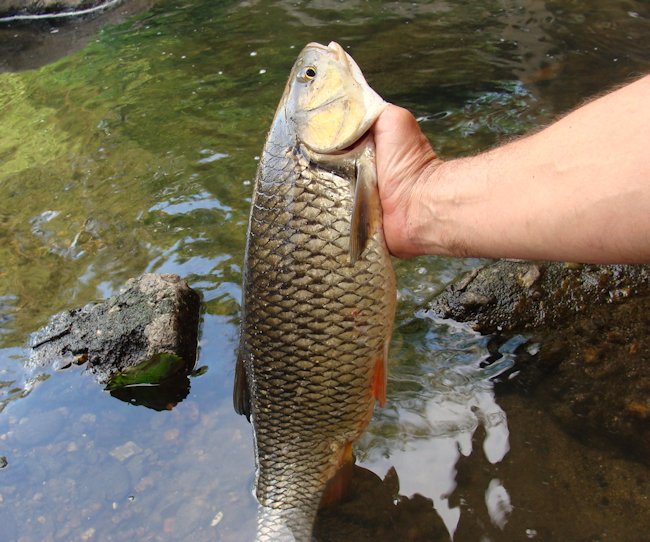Light Brown Daddy Long Legs Crane Fly
The large daddy longlegs fly is an ideal top dropper fly pattern to attract hungry rainbow of Brown Trout. If you go flyfishing on any large lake or reservoir from a boat, the tried and tested method of finding and catching fish is by using a rig of 3 to 4 flies.

Daddy Longlegs Dry Flies Hook size 10 - $US each
The larger hook nymph should be put on the end to weigh the rig down. One or two smaller flies should be tied on between the top and bottom flies. The top dropper fly is normally a large dry fly. Its function is to be visible on top of the water surface so you can see if any of the submerged flies have hooked a trout. They also cause a disturbance in the water surface, which can be seen for a number of feet underwater by lurking fish. Your action on the rod can also entice these fish to head up to the surface to investigate what might be caught drowning in the surface film. A big fly to a trout suggests a substantial meal worth the effort swimming from the bottom of the lake or reservoir to the top

The natural Daddy Long Legs Crane Fly
This type of fishing is ideal on summer days then there is a warm wind blowing on a cloudy day. I always use a longer fishing rod for boat work. You need the extra length to control the top dropper bob fly as far away the boat as you can. A 10 foot to 12 foot rod length is ideal. I usually use a floating line but I have my bag heavier fast sinking line in case the wind picks up and produces choppy waves on the lake surface. If that is the case I will change to the heavier line to be able to control more accurately the top fly on the surface.
Who designed the Daddy Longlegs Dry Fly?
Over the years there have been many Daddy Longleg crane fly fishing patterns. It was the famous British fly fisherman Richard (Dick) Walker who invented a Daddy Long Leg pattern that had the legs, tied from pheasant tail fibers trailing backwards, rather than stuck out at the side. He worked out how to simply imitate the bent "knee" of a crane fly's long leg by just tying a knot in the pheasant tail fiber. Simple but very effective. This technique is now used on other fishing fly patterns like the hopper and on certain stonefly nymph patterns. Richard Walker died in August 1985.
Dapping with a Daddy Longlegs Dry Fly
The fly fishing technique of dapping is both loved and loathed. This is due to its ability to turn a new beginner, armed only with a dapping rod and some big bushy flies, into a fish catching machine when out in the same boat as a supposedly skilful fly casting expert who turns into a cursing water whipping fish-less wreck at the same time.
On the other side of the coin, however, comes when you are dapping and you get a lovely head and tail rise in front of the boat and all you can hope is the trout decides to take your fly next, as casting is not an option. It is most potent with artificial daddy-longlegs, but there are variations
Dapping is very popular in Ireland where grasshopper and caddis patterns are also used along with daddy Longlegs. In Scotland, dapping for sea trout and salmon with teams of large bushy dapping flies is popular. I have had fantastic fishing trips on some of the larger reservoirs in England and Wales using a detached body daddy longlegs pattern in September and October.
When dappling I use a 15 foot rod and an old fly reel loaded h 8lb to 15lb braking strain monofilament. The fly is preceded by a length of foss attached around six feet from the hook. One essential element required for a good days dapping is the wind. The length of the foss is dictated by the strength of the wind. In a very strong wind no more than a foot of foss required. In lighter winds several feet of foss is needed to achieve the correct spinnaker effect which dances the flies enticingly over the surface.
Concentration is needed when dapping as you have to try to keep the nylon off the surface of the water and allow the artificial fly dance and in a natural way.
The takes are usually very subtle and when dapping the normal angler's reaction is to strike immediately. DON'T. All you will get back is a fish-less hook.
When a fish takes your dapped fly lower the rod and give the trout time to turn down with your fly and then lift into it. In most instances a trout, when hooked on the dap, is usually firmly hooked. Knots allowing it should be landed.
I like using the detached body style of Daddy longlegs patterns for dapping because the deer hair body is naturally buoyant and resists soaking up the water and sinking.
Customer's Comments
The daddy-longlegs imitation is one to pick when there is a big wave on the water. Treat the giant bushy hackles with a good dose of floatant such as Gink to make it near impossible to sink. Whenever the natural daddy longlegs are being blown onto the water and rolling waves are drowning the usual choice of surface dry flies, try this on a floating line bounced around on the wave tops. The trout are already on the prowl for these large insects that represent a lot of calories in one mouthful so hang on to your rod because I have found the takes can be explosive. Kevin White, Birmingham.
Customer's Photos

CUSTOMER'S PHOTOS
This 51cm chub was caught by Herve Raclot in France using a Daddy Longleg dry fly on hook size 10

CUSTOMER'S PHOTOS
This 2kg 53cm chub was caught by Herve Raclot in France using a Brown Daddy Longleg dry fly on hook size 10
Fly Fishing books



